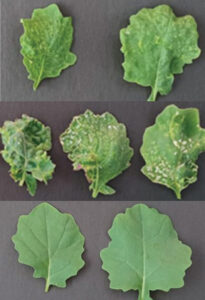New clues to sclerotinia stem rot resistance
KEY RESULT:
Researchers discover Resistance: Avirulence protein interactions between the S. sclerotiorum pathogen and canola plants. These interactions open the door to effector-guided breeding where one can select or engineer lines that no longer produce the corresponding necrosis-inducing protein receptor and are, therefore, immune to its effect.
PROJECT TITLE, PRINCIPAL INVESTIGATOR:
“Resistance to Sclerotinia sclerotiorum effectors in canola,”
Dwayne Hegedus, Agriculture and Agri-Food Canada Saskatoon
FUNDING:
AgriScience Program (Canola Cluster) under the Canadian Agricultural Partnership
PUBLISHED ARTICLES:
Seifbarghi S, Borhan MH, Wei Y, Ma L, Coutu C, Bekkaoui D and Hegedus DD (2020) Receptor-like kinases BAK1 and SOBIR1 are required for necrotizing activity of a novel group of Sclerotinia sclerotiorum necrosis-inducing effectors. Front. Plant Sci. 11: 1021. doi.org/10.3389/fpls.
2020.01021.
(Pub ID 48724).
Sclerotinia sclerotiorum, the fungal pathogen that causes sclerotinia stem rot in canola, produces substances that cause lesions on the plant or compromise the ability of the plant to defend itself against attack by the fungus.
Researchers aimed to dissect the processes the pathogen uses to cause stem rot disease in canola. This would give them a much better understanding of the pathogen and its relationship with the host plant, and also highly specific methods to identify Brassica napus (canola) lines that are resistant to the most important aspects of the disease. The goal is to advance the development of B. napus varieties with better tolerance to this difficult-to-control disease.
Objectives were to (1) examine the importance and mechanisms of action of S. sclerotiorum necrosis-inducing proteins, (2) identify effectors (secreted proteins and RNA) that S. sclerotiorum emits to suppress host defenses or alter host interactions, and (3) exploit these effectors/necrosis-inducing proteins to identify resistant B. napus cultivars.
Results
Using previous work to sequence the S. sclerotiorum genome, researchers identified 100 candidate genes encoding potential necrosis proteins secreted from S. sclerotiorum.

They then tested these candidate necrosis-inducing proteins on plants. Six of the candidates tested caused necrotic symptoms, thus validating the informatics analysis pipeline. Of the six new S. sclerotiorum necrosis-inducing proteins, five require interaction with a host cell surface receptor. This is similar to classic Resistance:Avirulence protein interactions, like canola has with the blackleg pathogen, for example, however, in this case the interaction of the necrosis-inducing proteins with the host receptor initiates a hyper-sensitive response that leads to necrosis.
With most other pathogens (viruses, plasmodia and biotrophs that cause diseases, such as clubroot and blackleg) the Resistance:Avirulence protein interactions would lead to resistance; however, with S. sclerotiorum the dead tissue provides nutrients to fuel the infection.
The principal investigator says this was an unexpected and exciting discovery. It opens the door to effector-guided breeding where one can select or engineer lines that no longer produce the corresponding necrosis-inducing protein receptor and are, therefore, immune to its effect. To this end, the researchers have now screened a diverse collection of B. napus accessions from AAFC and the Canadian Plant Gene Resources with a necrosis protein found in common in S. sclerotiourum and other canola pathogens. Accessions with reactions ranging from completely resistant to highly susceptible were identified. The genes and mechanisms underlying this phenomenon are under investigation.





